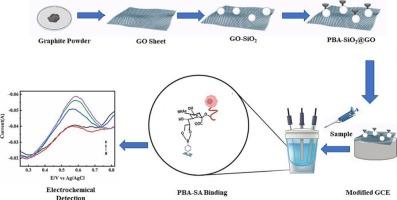Fabrication of phenylboronic acid modified graphene oxide-silica biosensor for label-free electrochemical detection of circulating tumor cells
IF 4.5
2区 化学
Q1 BIOCHEMISTRY & MOLECULAR BIOLOGY
引用次数: 0
Abstract
Early and accurate detection of circulating tumor cells (CTCs) is vital for cancer diagnosis and personalized treatment. Despite their clinical significance, the identification of CTCs remains challenging because of the biological complexity and lower concentration. Therefore, a cost-effective, and label-free electrochemical biosensor based on phenyl boronic acid functionalized graphene oxide-silica (PBA@GO-SiO2) is developed to selectively recognize sialic acid-rich glycoproteins on HepG2 cells. The electrochemical properties of developed biosensor confirm a concentration-dependent response upon interaction with HepG2 cells. The biosensor demonstrates a broad linear range of 50–105 cells/mL with LOD of 26 cells/mL. Electrochemical surface area (ECSA) and optimization studies verify the stable sensor performance across different scan rates and pH conditions. It also exhibits selectivity, reproducibility, and reusability while retaining 85 % original signal after multiple regeneration cycles. Overall, PBA@GO-SiO2 based biosensor is a scalable platform requiring small blood sample, eliminating the need for antibodies, ensuring long shelf life because of durable material, and carry translational potential at clinical level.

用于循环肿瘤细胞无标记电化学检测的苯基硼酸修饰氧化石墨烯-二氧化硅生物传感器的制备
循环肿瘤细胞(CTCs)的早期准确检测对于癌症诊断和个性化治疗至关重要。尽管ctc具有临床意义,但由于其生物学复杂性和较低的浓度,其鉴定仍然具有挑战性。因此,开发了一种基于苯基硼酸功能化氧化石墨烯-二氧化硅(PBA@GO-SiO2)的低成本,无标记的电化学生物传感器,以选择性识别HepG2细胞上富含唾液酸的糖蛋白。开发的生物传感器的电化学特性证实了与HepG2细胞相互作用时的浓度依赖性响应。该生物传感器具有50-105个细胞/mL的宽线性范围,LOD为26个细胞/mL。电化学表面积(ECSA)和优化研究验证了传感器在不同扫描速率和pH条件下的稳定性能。它还具有选择性,再现性和可重用性,同时在多次再生循环后保留85%的原始信号。总体而言,基于PBA@GO-SiO2的生物传感器是一种可扩展的平台,需要少量血液样本,消除了对抗体的需求,由于耐用的材料而确保了较长的保质期,并且在临床水平上具有转化潜力。
本文章由计算机程序翻译,如有差异,请以英文原文为准。
求助全文
约1分钟内获得全文
求助全文
来源期刊

Bioelectrochemistry
生物-电化学
CiteScore
9.10
自引率
6.00%
发文量
238
审稿时长
38 days
期刊介绍:
An International Journal Devoted to Electrochemical Aspects of Biology and Biological Aspects of Electrochemistry
Bioelectrochemistry is an international journal devoted to electrochemical principles in biology and biological aspects of electrochemistry. It publishes experimental and theoretical papers dealing with the electrochemical aspects of:
• Electrified interfaces (electric double layers, adsorption, electron transfer, protein electrochemistry, basic principles of biosensors, biosensor interfaces and bio-nanosensor design and construction.
• Electric and magnetic field effects (field-dependent processes, field interactions with molecules, intramolecular field effects, sensory systems for electric and magnetic fields, molecular and cellular mechanisms)
• Bioenergetics and signal transduction (energy conversion, photosynthetic and visual membranes)
• Biomembranes and model membranes (thermodynamics and mechanics, membrane transport, electroporation, fusion and insertion)
• Electrochemical applications in medicine and biotechnology (drug delivery and gene transfer to cells and tissues, iontophoresis, skin electroporation, injury and repair).
• Organization and use of arrays in-vitro and in-vivo, including as part of feedback control.
• Electrochemical interrogation of biofilms as generated by microorganisms and tissue reaction associated with medical implants.
 求助内容:
求助内容: 应助结果提醒方式:
应助结果提醒方式:


